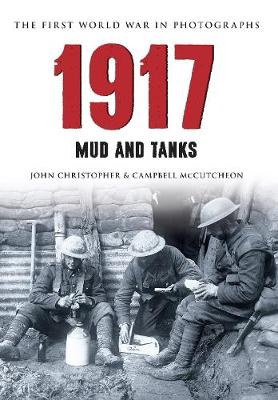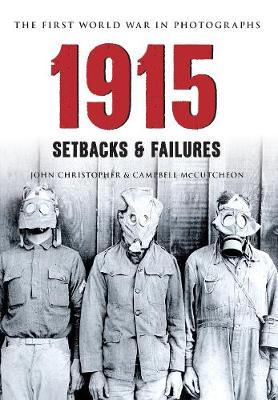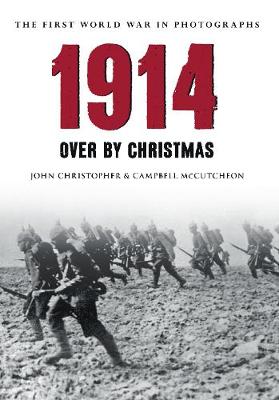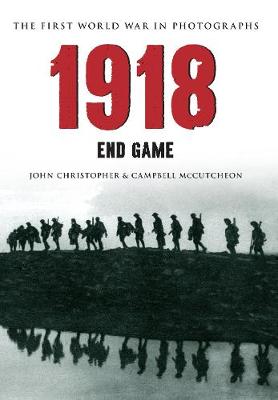The First World War in Photographs
5 total works
1917 The First World War in Photographs
by John Christopher and Campbell McCutcheon
Published 15 December 2014
1917, the fourth year of the Great War, saw another year in the trenches for millions of troops mobilised in Europe. Apart from short patrols in the North Sea, the ships of the Royal Navy and Germany's imperial navy remained in port. However, the enemy submarines were in operation intensively. In March, three American ships were sunk in one day, finally bringing the United States to the brink of war. President Woodrow Wilson made an impassioned speech to Congress, which voted for war. At the same time, Russia was in turmoil, with revolution breaking out in Petrograd, Moscow and other cities. While the Russians sued for peace with Germany and Austria-Hungary, from June onward, American soldiers began to flood into France at the rate of 300,000 a month. The Austro-Hungarians ended the year almost defeated, while the Germans knew that they had the opportunity for one final push for victory before they too would have to succumb to the weight of numbers of American troops landing at Brest and St Nazaire. The year also saw Lawrence of Arabia help the Arabs attack the Turks, the life-sucking mud of Passchendaele, the massed tank battle of Cambrai and multiple battles of the Isonzo on the border of Italy and Austria-Hungary.
John Christopher and Campbell McCutcheon tell the story of 1917 at war using many rare and often unpublished images, showing the full horror of the conflict, as well as its impact on the everyday person.
John Christopher and Campbell McCutcheon tell the story of 1917 at war using many rare and often unpublished images, showing the full horror of the conflict, as well as its impact on the everyday person.
1915 The First World War in Photographs
by John Christopher and Campbell McCutcheon
Published 15 August 2014
1915, the second year of the Great War, was to see the failure of the Dardanelles landings and the sinking of the Lusitania, shown below, with the loss of 1,198 people, as well as the first bombing of mainland Britain by Zeppelin and the entry of Italy into the war. Huge battles would be fought at sea and on land, while the fledgling air forces of the fighting powers clashed in the clouds. 1915 will be remembered not just for the Lusitania but also for that most inhumane and indiscriminate weapon, poison gas, its first use being against the Russians on the Eastern Front.
The Western Front was in stalemate, with the troops entrenched and little in the way of advance or retreat to counter the thousands of lives being lost on a daily basis. War in the east and in Mesopotamia was more fluid, with the armies of Germany, Turkey, Russia and Austria-Hungary moving over huge swathes of Central Europe and the Middle East.
John Christopher and Campbell McCutcheon tell the story of 1915 at war using many rare and often unpublished images, showing the full horror of the conflict, as well as its impact on the everyday person.
The Western Front was in stalemate, with the troops entrenched and little in the way of advance or retreat to counter the thousands of lives being lost on a daily basis. War in the east and in Mesopotamia was more fluid, with the armies of Germany, Turkey, Russia and Austria-Hungary moving over huge swathes of Central Europe and the Middle East.
John Christopher and Campbell McCutcheon tell the story of 1915 at war using many rare and often unpublished images, showing the full horror of the conflict, as well as its impact on the everyday person.
1914 The First World War in Photographs
by John Christopher and Campbell McCutcheon
Published 15 May 2014
1914: the first year of the 'war to end all wars', documented through old photographs. In 1914, after more than a decade of sabre-rattling, arms races and localised wars, mainland Europe erupted into the greatest war man had ever seen. The assassination of Archduke Franz Ferdinand saw the beginning of a conflict that was, according to some, going to be over by Christmas but which, in reality, lasted over five years. With battles on all fronts, from Russia to the Falklands, West Africa to China and the Middle East, at sea, on land and by the fledgling air forces of the world, 1914's war culminated in the famous football match on the Western Front on Christmas Day, but also saw the invasion of neutral Belgium, the Battle of the Marne and the sinking of the Kaiser Wilhelm der Grosse. The photographs tell the story of the world at war in a graphic and telling way.
The First World War changed the art of war forever, and not in a nice way. John Christopher and Campbell McCutcheon document the horrors of war in the photographs of those times.
The First World War changed the art of war forever, and not in a nice way. John Christopher and Campbell McCutcheon document the horrors of war in the photographs of those times.
1916 The First World War in Photographs
by John Christopher and Campbell McCutcheon
Published 15 October 2014
1916, the third year of the Great War, was to see the introduction of conscription for the first time in Britain to feed the insatiable demand for men at the Front. It was just as well, as the spring saw the launch of the German offensive at Verdun and the British counter-attack, but neither side achieved any significant gains. On 1 July the Allies experienced the bloodiest day of the war at the start of the Somme campaign with some 60,000 men killed in a single day. The British Mark 1 tank also made its combat debut at the Somme, heralding a new era of mechanised warfare. 1916 was also the year of the Battle of Jutland, which was the greatest naval encounter of the war but resulted in an inconclusive outcome with both sides losing many ships. Shortly afterwards Lord Kitchener died when HMS Hampshire hit a mine. Kitchener had become the iconic figure of the First World War, appearing on countless recruiting posters. On the Eastern Front the Russian forces pushed forward to draw the Germans into pulling their troops away from the Western Front.
John Christopher and Campbell McCutcheon tell the story of 1916 at war using many rare and often unpublished images, showing the full horror of the conflict, as well as its impact on the everyday person.
John Christopher and Campbell McCutcheon tell the story of 1916 at war using many rare and often unpublished images, showing the full horror of the conflict, as well as its impact on the everyday person.
1918 The First World War in Photographs
by John Christopher and Campbell McCutcheon
Published 15 March 2015
1918 was the fifth and final year of the Great War. With thousands of fresh American troops heading across the Atlantic to fight on the side of the Allies, Germany's High Command knew it had to strike a decisive blow to turn the course of the war in its favour. With revolution in Russia a peace treaty was agreed on the Eastern Front, enabling General Ludendorff to transfer seventy divisions to the west for a Spring Offensive that was intended to drive the French back to Paris and the British to the Channel ports. The Allied counter-offensive on the Marne began in July and, with the Americans joining the fighting, the Germans were forced back to the Hindenburg Line. Starved of food and supplies, Germany faced inevitable defeat and sought terms for a peace settlement. The Kaiser abdicated on 11 November 1918 and the guns become silent with the signing of the Armistice. In defeat Germany was humiliated and economically paralysed by the demand for war reparations imposed by the Treaty of Versailles, which was signed in June the following year. But for both sides the real cost of the war was measured in human lives. Twenty million were killed and the participating European nations all but bankrupted. The political map was irrevocably changed and the so-called 'war to end all wars' was the harbinger of an even greater conflict yet to come.
John Christopher and Campbell McCutcheon tell the story of 1918, the final year of fighting, and also the immediate post-war period, using many rare and often unpublished images.
John Christopher and Campbell McCutcheon tell the story of 1918, the final year of fighting, and also the immediate post-war period, using many rare and often unpublished images.




